Struggling to get shoppers’ attention? Discover how to effortlessly optimize SEO, AEO, GEO for fashion product pages with AI-powered optimization.
by YesPlz.AIAugust 2025

Online shoppers no longer stick to a single platform when searching for products. They might start with traditional search engines such as Google, Bing, or Yahoo. Then, ask AI chatbots like ChatGPT, Claude, or Gemini. Finally, buy through generative shopping assistants, such as AI stylists or personal shoppers.
For this reason, being visible in only one channel is no longer enough. Not only must your product pages be readable by search engines. But they should also be helpful enough to be quoted or summarized by AI chatbots. That means your product detail pages must serve traditional SEO, AEO, and GEO at once.
What happens if you don’t optimize SEO, AEO, GEO for fashion product pages? Your competitors’ products will be recommended instead of yours. This directly translates into missed clicks, weaker brand visibility, and lower sales.
The good news? With AI, you can scale product page optimization across thousands of SKUs without extra staff. This article shows you how to leverage SEO, AEO, and GEO to get your products seen everywhere.
Table of Contents:
SEO, AEO, and GEO may sound like buzzwords. But they’re the backbone of modern product discovery.
SEO stands for Search Engine Optimization. Following best SEO practices helps your product detail pages rank high in search engine results.
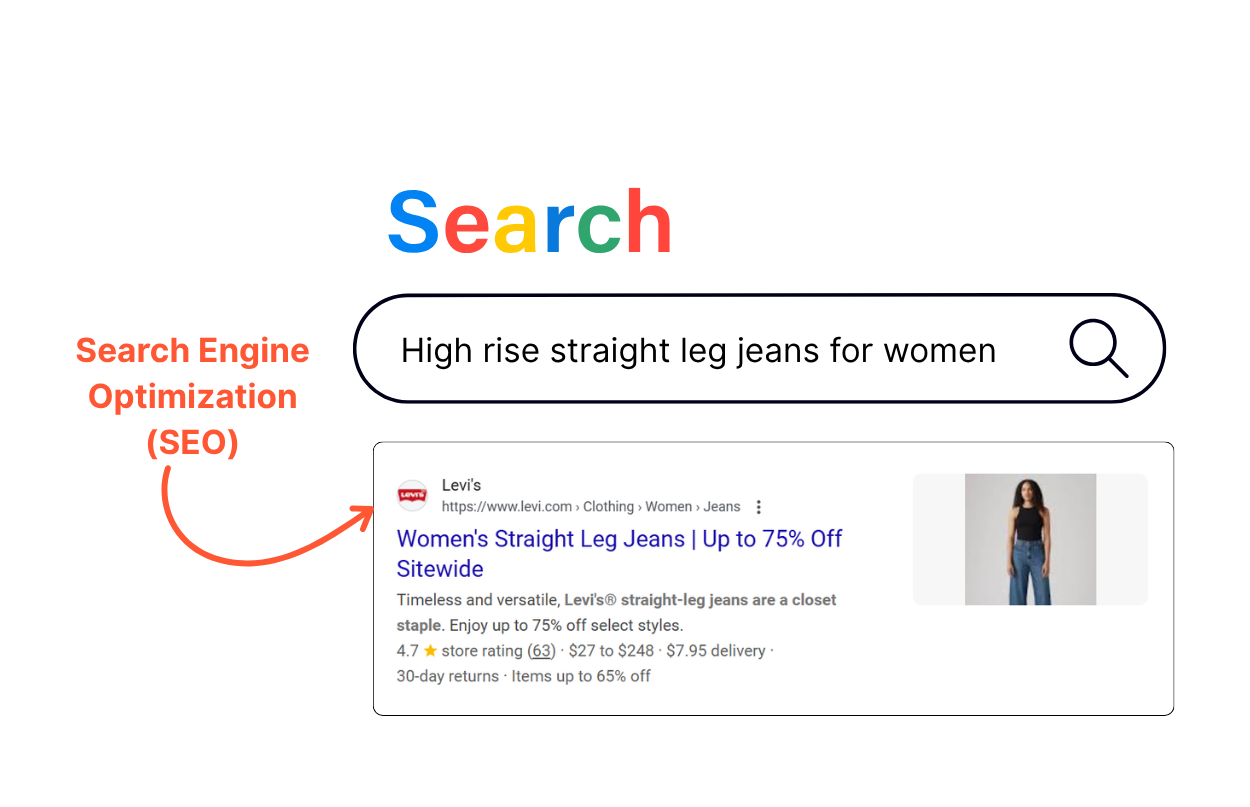 AEO, or Answer Engine Optimization, enables AI chatbots to discover and recommend your product pages as one of the options.
AEO, or Answer Engine Optimization, enables AI chatbots to discover and recommend your product pages as one of the options.
 GEO (Generative Engine Optimization) ensures your product pages are referenced and cited in AI-generated responses.
GEO (Generative Engine Optimization) ensures your product pages are referenced and cited in AI-generated responses.
 The shopper journey is no longer linear. It’s fragmented across search results, AI answers, and generative shopping recommendations. For shoppers to consistently find your products in this new landscape, you must cover all three fronts. Ignoring any one of them weakens your chances of being discovered.
The shopper journey is no longer linear. It’s fragmented across search results, AI answers, and generative shopping recommendations. For shoppers to consistently find your products in this new landscape, you must cover all three fronts. Ignoring any one of them weakens your chances of being discovered.
Now that you know why these three areas matter. Let’s look at the product detail page elements you need to optimize to put them into action. What are the best ways to improve SEO, AEO, and GEO for fashion product pages? What elements should you optimize?
Optimizing product detail pages doesn’t happen in isolation. Each relies on the same set of core elements that make your products both discoverable and persuasive. From the meta titles shoppers first see in search results to the reviews that confirm product quality. Each of them plays a role in whether your products are found.
Key checklist for optimizing SEO, AEO, GEO for fashion product pages includes:
Unique and relevant meta titles and meta descriptions
Unique, relevant product titles and structured product descriptions
Breadcrumbs with clear category structures
Alternative text for images
Similar, complementary, and frequently bought together recommendations
Shopper reviews and social proof
Search engines use these elements to decide ranking positions. AI chatbots scan them to recommend products. And generative engines pull them into shopping guides. In short, the quality of these elements determines whether your product appears in any place shoppers search. This is why adopting AI optimization for fashion product pages is critical for success.
A meta title is a blue, clickable headline that appears in search results. It tells both shoppers and search engines what your product page is about. A meta description is under the blue headline. It is a short gray text that provides a quick summary of a page. By reading it, shoppers can decide whether or not to click.
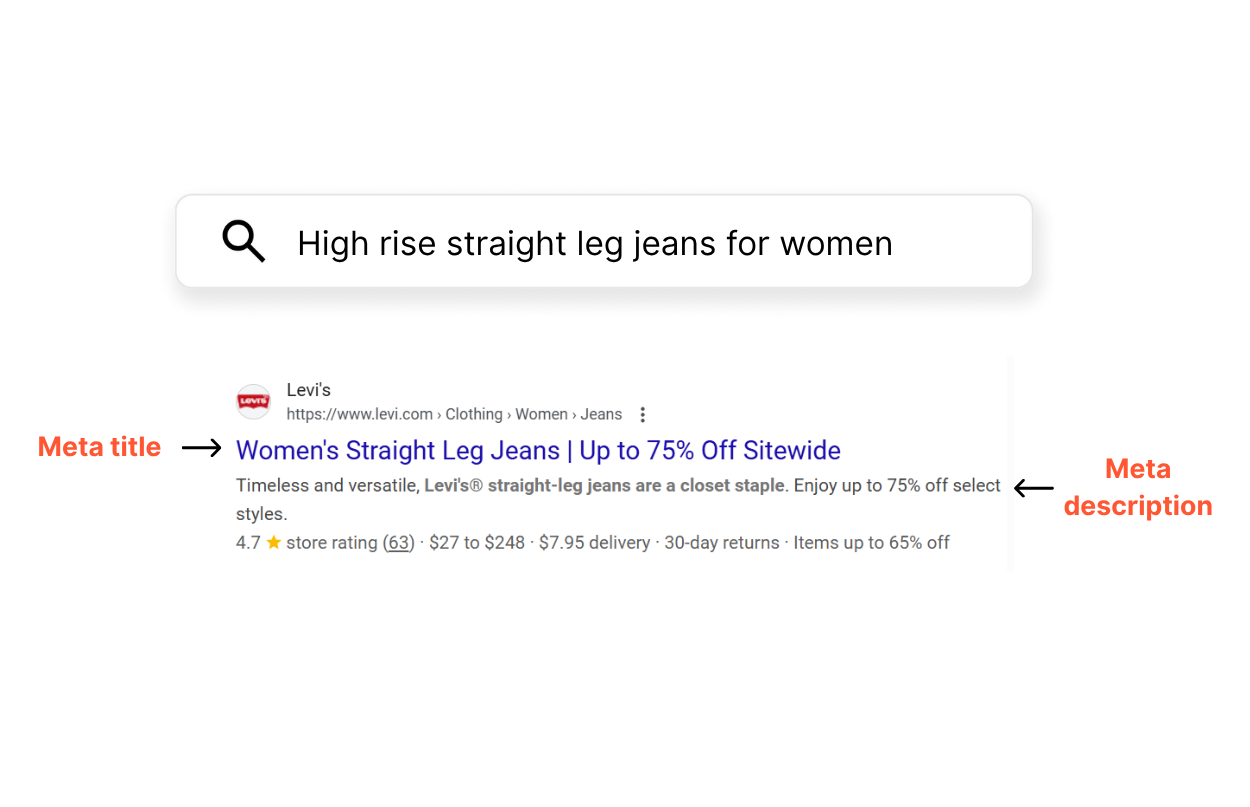 Meta titles and meta descriptions act as the shop window for every product detail page. If they’re blank or duplicated, search engines like Google will generate their own, often producing unclear, incomplete, irrelevant ones. This leads to lower ranking positions, lower click-through rates (CTR), and wasted impressions.
Meta titles and meta descriptions act as the shop window for every product detail page. If they’re blank or duplicated, search engines like Google will generate their own, often producing unclear, incomplete, irrelevant ones. This leads to lower ranking positions, lower click-through rates (CTR), and wasted impressions.
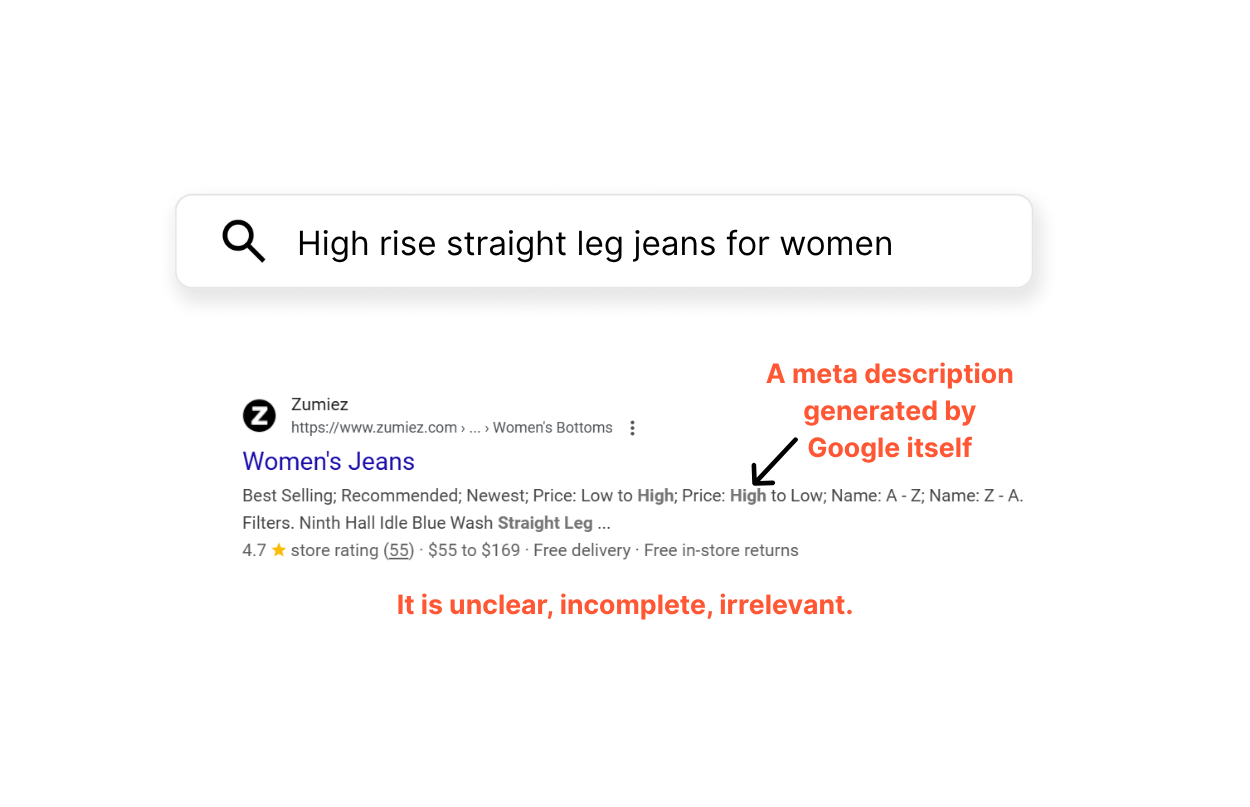 Instead, every product page should have a unique meta title and meta description. Key information, for instance, gender, product type, material, and color, should be clearly stated. They should be precise and compelling. Plus, they should be short enough to avoid being cut off.
Instead, every product page should have a unique meta title and meta description. Key information, for instance, gender, product type, material, and color, should be clearly stated. They should be precise and compelling. Plus, they should be short enough to avoid being cut off.
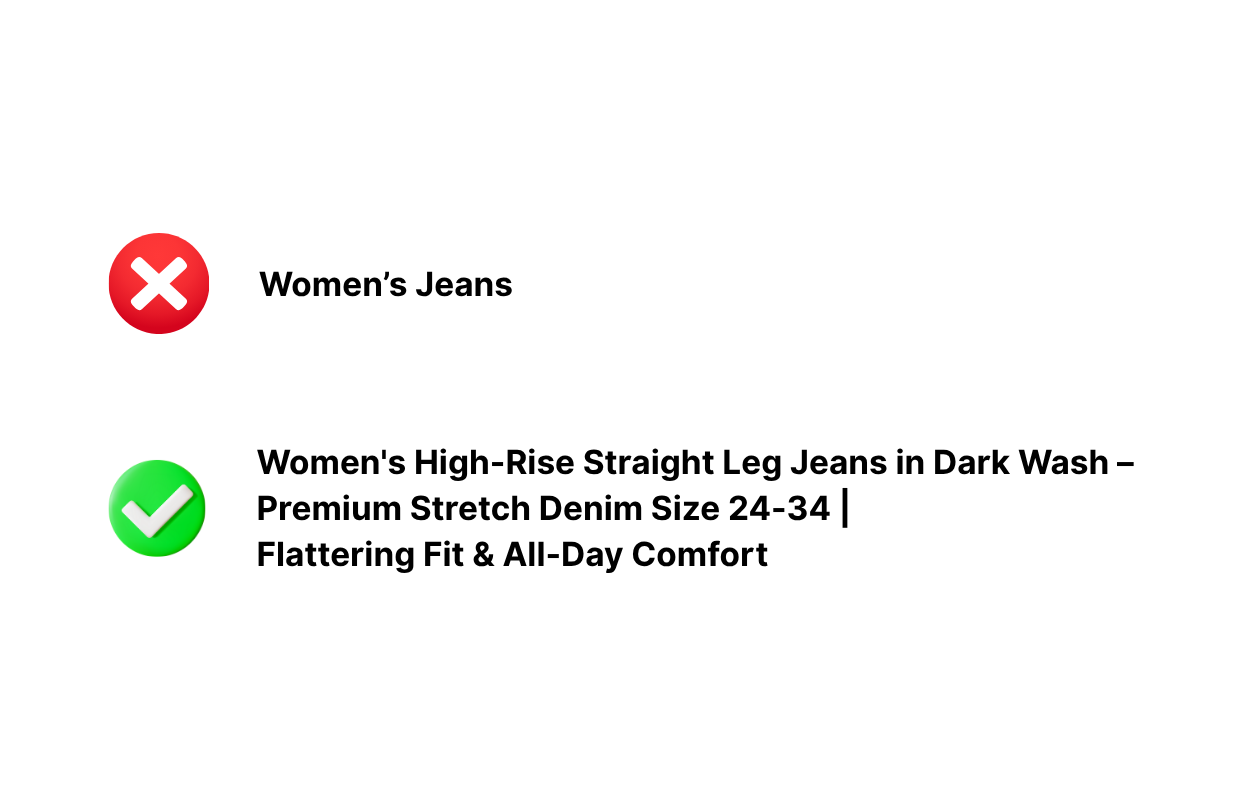 When done right, these optimized metadata set clear expectations, attract clicks, and reduce bounce rates because shoppers know exactly what they see. They help increase CTRs while signaling relevance to both search engines and AI platforms. This step is vital for SEO for fashion eCommerce.
When done right, these optimized metadata set clear expectations, attract clicks, and reduce bounce rates because shoppers know exactly what they see. They help increase CTRs while signaling relevance to both search engines and AI platforms. This step is vital for SEO for fashion eCommerce.
Product titles and product descriptions should also be clear, keyword-rich, and specific to each SKU. Especially, product descriptions should be logically structured.
A structured product description is information written in a format that computers can easily understand. It should include bullet-pointed attributes like product name, price, size, color, availability, and reviews.
Search engines and AI platforms don’t see your products the way humans do. They rely on structured data instead. They use this data to show your products in special results such as product listings, price comparisons, or AI shopping guides.
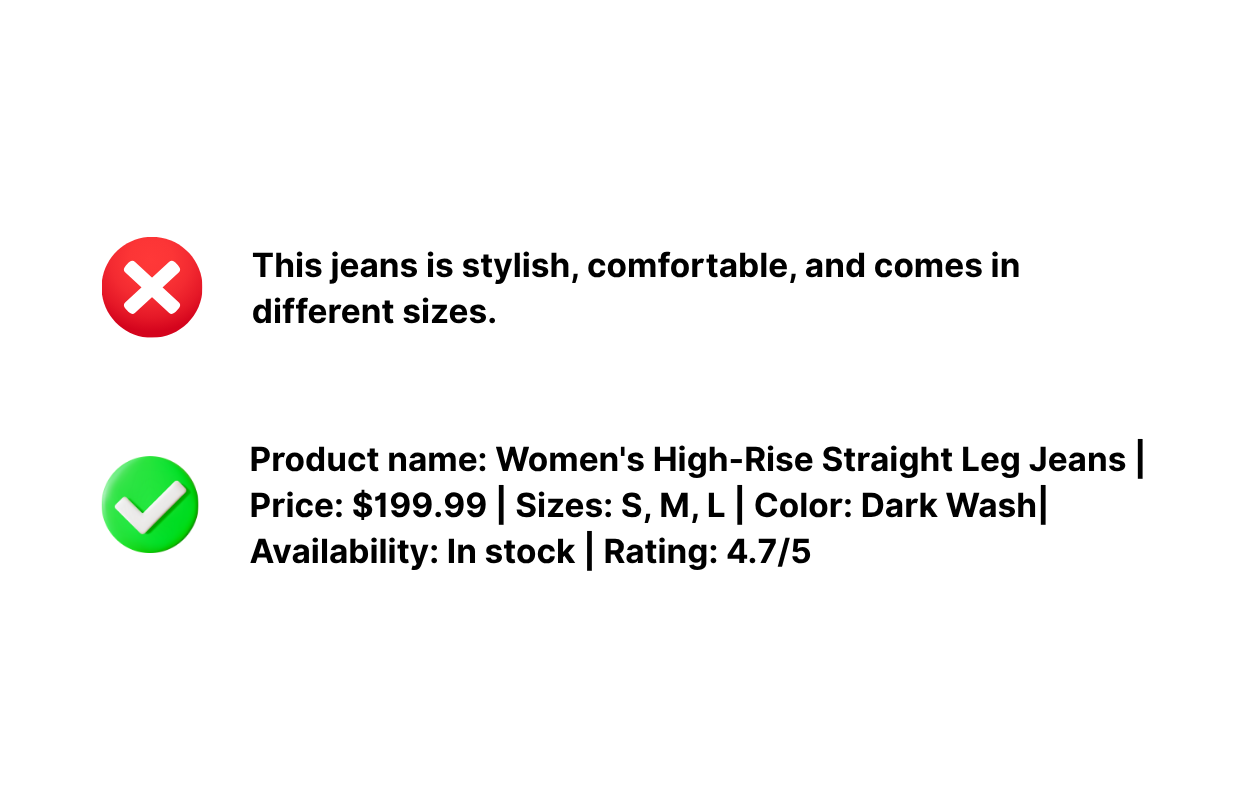 When written in a structured way, search engines and AI platforms can display the price, rating, and stock right. As a result, your products are more visible and clickable.
When written in a structured way, search engines and AI platforms can display the price, rating, and stock right. As a result, your products are more visible and clickable.
Breadcrumbs are the navigation paths that show where a product page sits within your website’s hierarchy (e.g., Home > Women > Clothing > Tops > Crop Tops). They’re not just useful for shoppers. They’re also critical for optimizing SEO, AEO, GEO for fashion product pages.
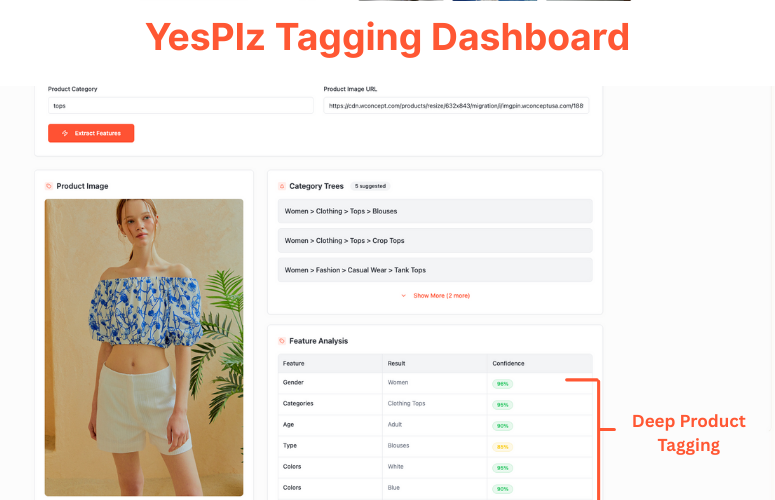 For search engines, breadcrumbs help crawlers understand your site structure. They strengthen internal linking and signal the relationship between categories and products. This improves indexation and can lead to breadcrumb-rich snippets in search results.
For search engines, breadcrumbs help crawlers understand your site structure. They strengthen internal linking and signal the relationship between categories and products. This improves indexation and can lead to breadcrumb-rich snippets in search results.
For AI chatbots and generative engines, clear category structures make it easier for AI systems to classify your products accurately and recommend them under the right context. Let’s say, “best women’s maxi dresses for summer weddings”.
For shoppers, breadcrumbs improve navigation, reduce bounce rates, and encourage exploration across related categories.
To optimize breadcrumbs, make sure they:
Follow a logical hierarchy (broad → specific)
Use keyword-rich, human-readable labels
Link back to relevant category and subcategory pages
Stay consistent across your entire catalog
Following these best practices, breadcrumbs act as both a navigation aid and a contextual signal. The result? Clear structures boost discoverability in search engines, answer engines, and generative engines.
Simply put, ALT text tells search engines and AI platforms what your product images contain. Descriptive, keyword-optimized ALT text increases the chances of your images appearing in Google Images, AI answers, and generative recommendations.
Cross-linking products strengthens your internal linking structure and improves session duration. For shoppers, it adds value by suggesting curated outfits or related items, which generative engines may also surface in shopping guides. The importance of these elements will be explained in Step 5: Enhance the Pages with Linking Strategies in the next section.
Shoppers’ reviews are an untapped goldmine for fashion product page optimization. Instead of showing only star ratings, fashion retailers can extract recurring themes from reviews and surface them as benefits. Let’s say if many shoppers mention “lightweight but warm” for a jacket, that should be a featured bullet in the meta description and product description.
These insights make product pages more persuasive for shoppers and more useful for AI platforms. Generative engines often pull from customer-centric content. This means your products are more likely to be featured in AI shopping guides.
Together, these elements determine how well your product detail pages perform across search engines, answer engines, and generative engines. When optimized with AI-driven tools, they not only boost visibility but also create a consistent, persuasive experience for every shopper. Let’s see how AI helps you do it faster and at scale.
Manually optimizing SEO, AEO, and GEO for fashion product pages at scale can feel overwhelming. But fashion AI can make the process effortless. This section explains a step-by-step approach that combines automation with data insights.
 The first step starts with creating accurate and consistent product descriptions directly from product images.
The first step starts with creating accurate and consistent product descriptions directly from product images.
AI Image Recognition Technology: Deploy fashion-specialized AI systems that can identify and catalog product attributes directly from images.
Style classification (A-line, bodycon, wrap…)
Pattern recognition (floral, striped, solid, geometric…)
Color identification (specific shades, not just basic colors)
Silhouette analysis (fitted, loose, structured…)
Detail recognition (buttons, zippers, embellishments…)
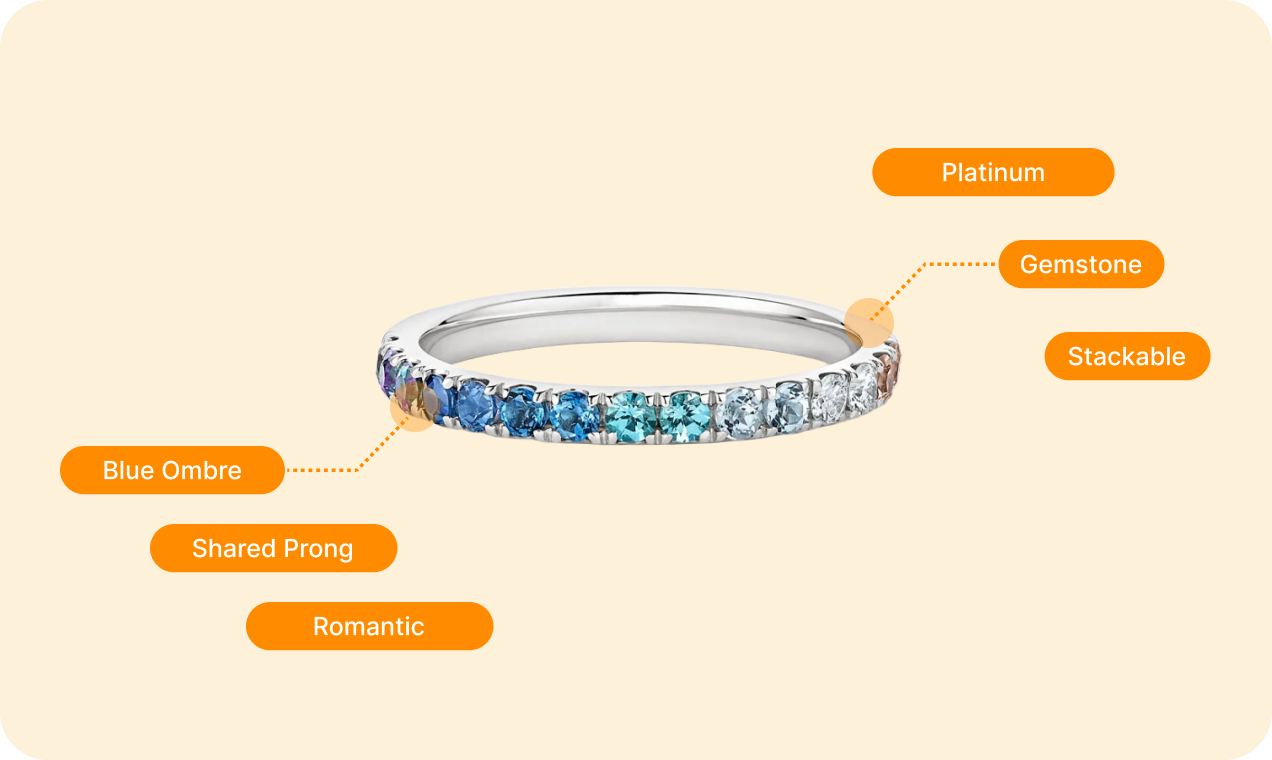 Benefits:
Benefits: Ensure consistency across all products
Capture details that might be missed in manual descriptions
After cataloging your product attributes, the next step involves leveraging fashion AI to enhance these attributes using real insights from shoppers.
Sentiment Analysis Integration: Fashion AI technology analyzes review sentiment and extracts the most frequently mentioned positive attributes.
Identify recurring descriptive phrases
Analyze sentiment context (positive vs. negative mentions)
Prioritize attributes mentioned by verified purchases
Track seasonal and trend-based feedback patterns
Feed extracted insights into the product descriptions
Create unique, customer-validated selling points that resonate with potential buyers
Following the extraction of the strongest selling points, AI technologies test how well they perform in titles and descriptions.
A/B Testing Framework: Implement systems that test multiple variations of meta titles and meta descriptions to identify the highest performing formats.
Keyword placement (front-loaded, balanced…)
Emotional triggers (luxury, comfort, style…)
Practical benefits (versatile, easy-care, sustainable…)
Price positioning (value, premium, accessible…)
CTRs from search results
Bounce rates on product pages
Conversion rates
Search ranking improvements
But testing alone isn’t enough. You must track results in an analytics dashboard to see what truly works.
Comprehensive Monitoring Setup: Connect optimization efforts to detailed analytics that track performance across multiple channels.
Search Performance: Rankings, impressions, clicks for target keywords
All Inclusion: Mention in AI-generated responses and recommendations
User Engagement: Time on page, bounce rate, pages per session
Conversion Tracking: Add-to-cart rates, purchase completion, revenue attribution
Continuously refine strategies for optimizing SEO, AEO, GEO for fashion product pages based on data insights rather than relying on guesswork.
When you know which changes drive results, the final step is to strengthen your product detail pages with links that boost overall SEO, AEO, and GEO performance.
Internal Linking Strategy: Establish intelligent product relationships that boost both SEO and shopper experience.
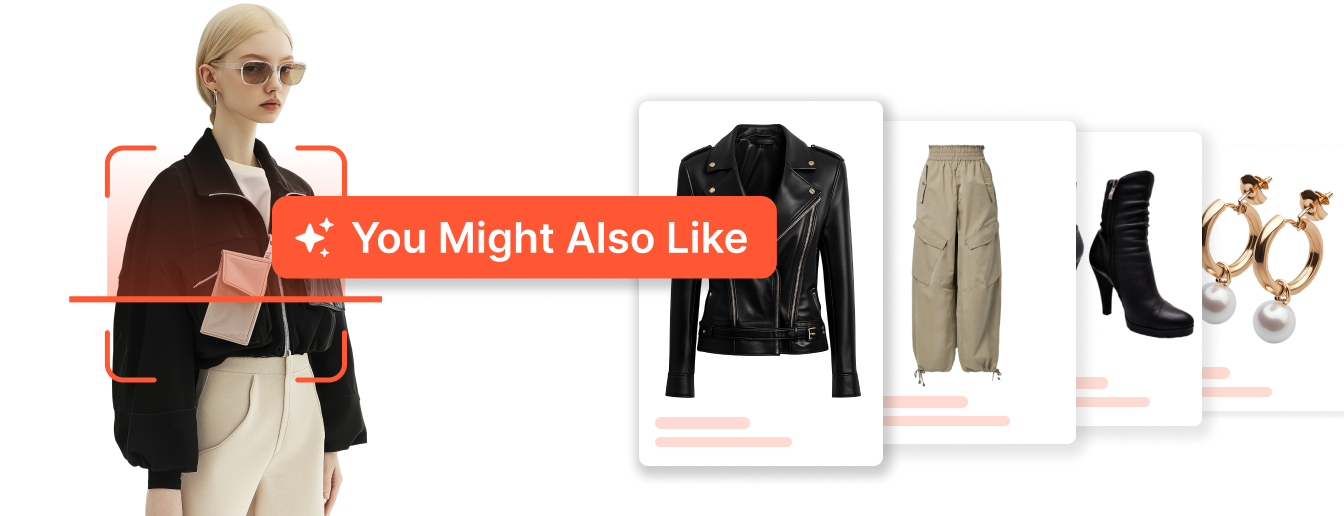
You Might Also Like: AI-powered recommendations based on style, price, and shopper behavior
Complete the Look: Curated bundles that encourage high-value orders
Category Cross-Link: Connect related items across different product categories
Seasonal Connection: Dynamic links that update based on current trends and seasons
Improve search engine crawl depth and indexing
Increase average session duration and pages per visit
Build topical authority for category pages
Reduce bounce rates through relevant product discovery
Following these steps can transform your product detail pages. To see the differences clearly, let’s compare a page before and after AI optimization.
To see the real impact of AI-powered optimization, it helps to compare what fashion product pages look like before and after applying these methods. Let’s start with the “before” stage, where most product detail pages struggle to rank, convert, or engage shoppers.
Before optimization, many fashion retailers unknowingly leave money on the table. They don’t have time working on meta titles, meta descriptions, and product descriptions. These core elements are often outdated, duplicated, or left blank. Search engines automatically generate unclear, irrelevant, and inconsistent ones. Shoppers don’t feel interested when they see them. As a result, they skip your product pages, and your CTRs stay low.
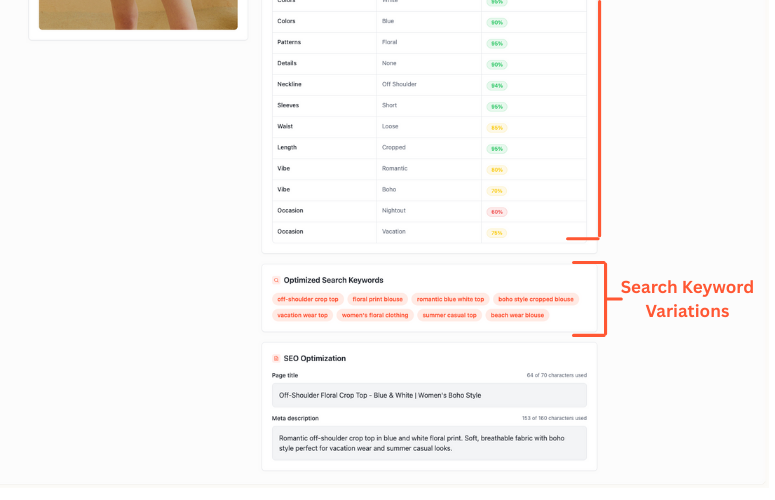 After optimization, the differences are clear. Meta titles and meta descriptions for each SKU are descriptive and engaging, and match the product descriptions. These elements communicate the unique value of a product. It highlights gender, material, color, and fit, making your listing more relevant to shoppers’ intent. Shoppers’ reviews are integrated to surface key benefits, such as “comfortable for all day wear” or “fits true to size.”
After optimization, the differences are clear. Meta titles and meta descriptions for each SKU are descriptive and engaging, and match the product descriptions. These elements communicate the unique value of a product. It highlights gender, material, color, and fit, making your listing more relevant to shoppers’ intent. Shoppers’ reviews are integrated to surface key benefits, such as “comfortable for all day wear” or “fits true to size.”
Optimizing SEO, AEO, GEO for fashion product pages can create measurable results across the customer journey. In terms of SEO, retailers can expect improved search visibility through structured data and high-quality metadata. For AEO, answer engines are more likely to pick your product pages as a direct answer when shoppers ask things like “What’s the best blazer for summer?” For GEO, your product detail pages become sources that generative AI systems reference when building recommendations. This comprehensive approach is the future of SEO for fashion eCommerce.
The era of “SEO only” is over. To stand out, it’s necessary to optimize SEO, AEO, GEO for fashion product pages together. This strategy succeeds because it aligns with how both search engines, AI platforms, and humans consume information.
Search engines reward structured, consistent, keyword-rich data with higher rankings. Answer engines prefer content that directly addresses user needs in a clear, human-friendly way. Generative AI systems rely on well-structured sources to generate accurate responses, meaning your product pages are more likely to be cited.
By combining all three, you create a product ecosystem that performs across every discovery channel. Instead of just hoping your products appear, you make it easy for both humans and AI to choose your brand first.
With fashion AI-driven tools, scaling fashion product page optimization across thousands of SKUs is not only possible but necessary to stay competitive. The brands that move first will dominate the future of product discovery. The payoff is huge: more visibility, more clicks, and more sales, all without hiring extra staff.
Ready to transform SEO for fashion eCommerce? Book a demo with us to explore our fashion AI. The technology exists. The opportunity is now. And your shoppers are waiting to discover what you have to offer.

Written by YesPlz.AI
We build the next gen visual search & recommendation for online fashion retailers
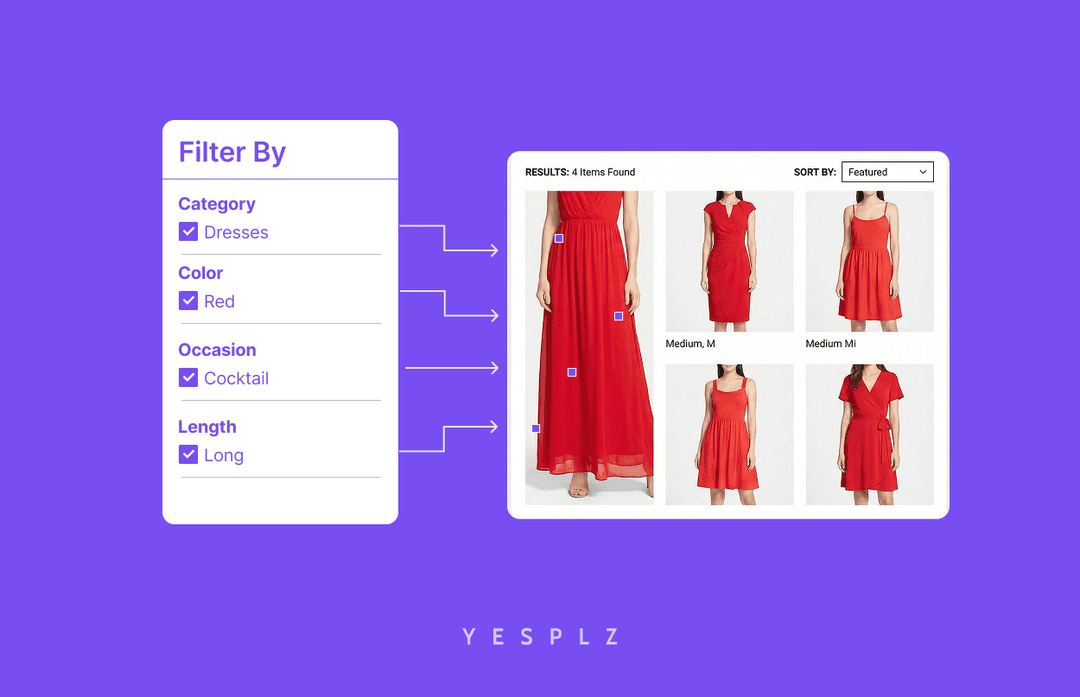
Stop losing sales to poor product filtering. Discover how AI simplifies creating Shopify filters, saving you 25-50 hours per 100 products.
by YesPlz.AI
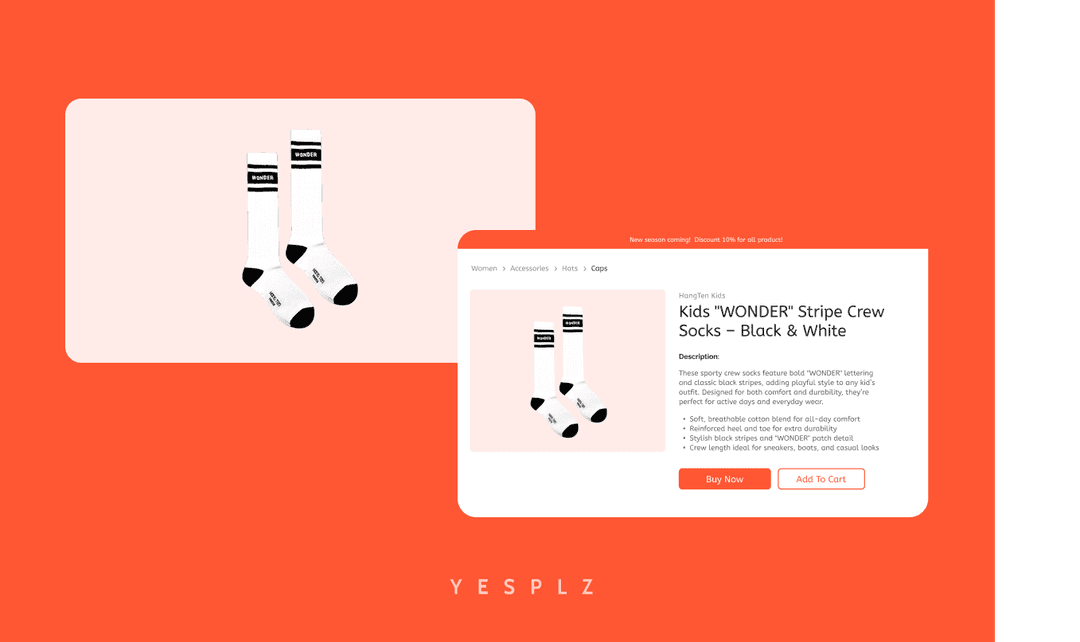
Automate Shopify product pages and cut 50–100 hours of manual work. AI generates product titles, descriptions, and metadata instantly from product images.
by YesPlz.AI